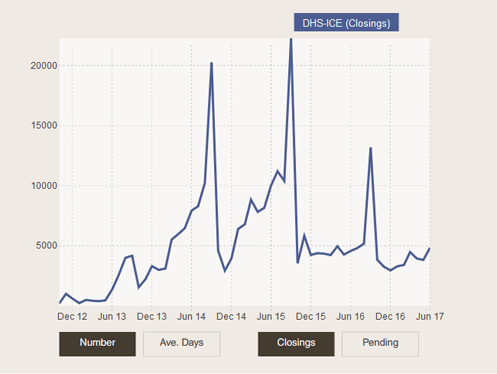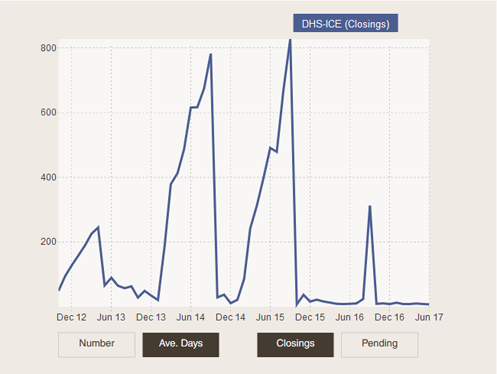Crisis Management Now Routine at ICE FOIA Office
A classic picture of crisis management emerges from more than four years of case-by-case records from the FOIA office of Immigration and Customs Enforcement, updated through June 2017. When monthly case closings are plotted, case processing shows anything but an even flow. See Figure 1.
 Figure 1. Number of ICE FOIA Requests Closed, by Month
Figure 1. Number of ICE FOIA Requests Closed, by MonthRevealed instead is a mad scramble to close out backlogged FOIA requests each September – no doubt timed to beat the deadline for filing the agency’s annual report. In 2016, for example, the monthly FOIA closures numbered around 4,500 each month. Then in September they nearly tripled, jumping to 13,205, before returning in October back down to 3,840.
This was not a one-time freak occurrence. As shown in Figure 1, similar jumps in FOIA closings – indeed some even larger — can be observed in September 2014, and September 2015. See Figure 1.
When this picture is paired with a second showing how long cases have waited before they were closed, an equally disturbing pattern is seen. The sets of cases closed each September appear very different in composition from those typically processed during the rest of the fiscal year. During the first eleven months of FY 2016, for example, FOIA cases closed took on average 10-20 calendar days from receipt to closure. Then in September, the average closure time in that single month jumped to 313 calendar days! See Figure 2.
 Figure 2. Average Calendar Days ICE FOIA Requests Took to Close, by Month
Figure 2. Average Calendar Days ICE FOIA Requests Took to Close, by MonthSimilar jumps in processing time can be observed in September during each of the two previous fiscal years.
Figures 1 and 2 in combination point to severe management problems plaguing ICE’s FOIA office. FOIA managers do not appear to monitor the processing of FOIA requests on a regular basis to ensure requests move smoothly through their work queues. Instead, ICE managers allow many requests to stall somewhere in the process until the end of the fiscal year approaches. Only then is there any apparent systematic attempt to ensure that older cases get attention and a frantic rush to close out stalled cases occurs.
While some effort to close out cases in September may be natural, the lack of attention given to ensuring a smooth flow of cases throughout the rest of the year is not only undesirable but counter-productive.
Answers to some requests are needlessly delayed in violation of timeliness requirements in the law. The quality of some responses that requesters receive surely suffer in such an intense push to close cases. And the pressure on FOIA staff to cut corners to speed case closures can hardly make the office a desirable place to work. For full details, see Agency FOIA Backlogs and Processing Times tool.
